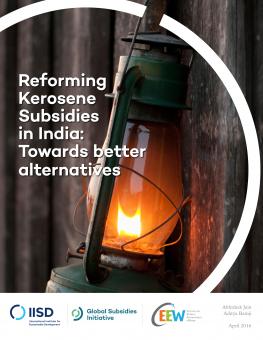
Reforming Kerosene Subsidies in India: Towards better alternatives
This study aims to address the key question of how to best rationalize the kerosene subsidy to improve the government effectiveness as well as provide the maximum benefit to the households spending on the fuel. The report finds that subsidizing kerosene essentially fails to meet the objective of providing affordable cooking and lighting service to households.
For the past 60 years kerosene in India has primarily been available as a subsidized commodity for households as an affordable cooking and illumination (lighting) fuel.
However, the subsidy program in its current form is marred by high levels of leakage in distribution. With efficient alternatives emerging to provide the end services being met by kerosene, continuing to subsidize it may not be the most efficient use of fiscal resources. This study aims to address the key question of how to best rationalize the kerosene subsidy to improve its effectiveness as well as provide the maximum benefit to the households using the fuel.
The report analyzes the current role and use of kerosene in Indian households, using National Sample Survey (NSS) data on consumer expenditure, Council on Energy, Environment and Water’s (CEEW’s) primary survey on energy access (ACCESS), and findings from field studies conducted in urban-poor sections of two cities, namely Kanpur and Bengaluru. It also analyzes the inefficiencies in the current delivery system and conducts an economic analysis of kerosene vis-à-vis alternatives.
The report finds that subsidizing kerosene fails to meet the objective of providing affordable cooking and lighting service to households. There is a clear case for alternatives to replace kerosene for its end services that could include any of the following: off-grid lighting, clean cooking provision or a direct benefit transfer for kerosene (DBT-K).
You might also be interested in
India Faces Clean Energy Challenges as Energy Demand Soars and Global Fossil Fuel Subsidies Rise
New research finds the global energy crisis and increasing energy demand have pushed India's energy subsidies to a 9-year high.
G20 energy ministers call for cooperation on nuclear energy & low-emission hydrogen
The Group of 20 energy ministers' meeting concluded in Goa on July 22, 2023, with the final summary failing to include language on the phase-down of unabated fossil fuels.
Implementing Solar Irrigation Sustainably
This guidebook provides recommendations to state policy-makers on how they can implement solar irrigation models, particularly decentralized solar plants for irrigation under the PM-KUSUM scheme, effectively and sustainably.
G20 Finance Ministerials and World Bank/IMF Spring Meetings: Expert comment
G20 finance ministerials and World Bank/IMF spring meetings will take place this week in Washington. High on the agenda is the need to mobilize trillions of dollars of investment in the transition to clean energy.